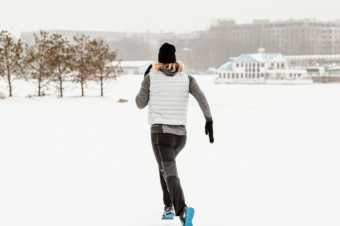

How to Avoid Common Bike Injuries Linked To Winter Cycling
BlogClub SportsHealth & FitnessHigh School CyclingNewsNewsTickerOutdoorStaffPicks November 4, 2024 Lauren Keating 0

With winter around the corner, cyclists are gearing up to brave colder, slicker conditions on the road. But as temperatures drop and daylight fades, cycling experts are cautioning riders about the increased risk of seasonal injuries linked to riding in the winter.
From slips on icy paths to joint pain from chilly weather, winter presents challenges even for seasoned cyclists.
“Winter riding gets a bad rap,” John Vinton, a representative of Aventon Bikes said. Yet, many people prefer the solitude of the road or trails and enjoy outdoor exercise in colder weather.
“There are plenty of things you can do to enjoy riding throughout the winter while still staying safe and preventing injury,” Vinton added.
With the right tips, cyclists can continue to enjoy this activity safely throughout the upcoming season.
The following are the most common bike injuries to watch out for during the colder months and practical tips on how to prevent them, so you can stay safe and keep riding all season long.
1. Slips and Falls
Winter hazards on icy roads and wet leaves can create slick surfaces that increase the risk of cyclists losing control and taking a spill. These falls can result in fractures, sprains, or bruises.
Prevention Tips:
- Tire Choice: Equip your bike with wider tires or winter-specific tires that offer better grip on slippery surfaces.
- Ride Defensively: Slow down, especially on corners and downhill sections. Keep a steady pace and avoid sudden movements.
- Stay Alert: Watch for black ice, wet leaves, and other hazards. Anticipate changes in terrain and adjust accordingly.
- Protective Gear: Wear a helmet and consider additional padding or winter cycling gloves with palm protection.
2. Hypothermia and Frostbite
Prolonged exposure to cold temperatures can lead to hypothermia or frostbite on fingers, toes, and ears. This not only affects health but also comfort and can impair your ability to control the bike.
Prevention Tips:
- Layer Up: Dress in moisture-wicking base layers, insulating mid-layers, and windproof outer layers. Remember that staying dry is key to staying warm.
- Protect Extremities: Wear thermal gloves, wool socks, and an insulated cap or headband under your helmet.
- Stay Dry: Choose waterproof or water-resistant gear to prevent rain or snow from soaking your clothing.
- Plan Your Route: Opt for shorter rides during extreme cold and ensure you have opportunities to warm up if needed.
3. Joint Pain
The repetition of pedaling causes knee and ankle joints to absorb a lot of shock from uneven and slippery road surfaces. The constant jarring and twisting motions can cause wear and tear on the joints, resulting in pain and inflammation.
Icy roads and increased precipitation can significantly increase the chances of experiencing joint pain while cycling.
“Before heading out on your bike, stretch your muscles and joints for a few minutes. Focus on areas that tend to feel tight or uncomfortable, such as your knees, hips, and ankles,” Vinton said. “Also, make sure your bike is fitted to your body so that you’re in a comfortable riding position. Your handlebars should be at a height that allows you to maintain a slight bend in your elbows while gripping them.”
4. Tendon Injuries
Tendons are connective tissues that attach muscle to bone and transmit the muscle’s force to the bone to create movement. When exposed to cold temperatures, these tissues can become less flexible. This decrease in flexibility can make them more susceptible to tears or strains, which result from cycling’s repetitive motion.
“To minimize the risk of tendon injuries, perform basic stretching exercises, paying particular attention to the legs and lower back muscles as an extra precaution,” the CEO of the high-performance electric bike company said. “This will stimulate blood flow and prevent the tendons from seizing.”
5. Reduced Visibility Leading to Accidents
Shorter daylight hours and inclement weather like fog, rain, or snow can reduce visibility, increasing the risk of collisions with vehicles or other obstacles.
Prevention Tips:
- High-Visibility Clothing: Wear bright or reflective clothing to make yourself more noticeable to drivers and other road users.
- Bike Lights: Use front and rear lights, even during daylight hours. Consider additional lights on your helmet or wheels.
- Eye Protection: Wear clear or light-tinted glasses to protect your eyes from wind and precipitation without compromising visibility.
- Follow Traffic Laws: Obey all traffic signals and signs, and make predictable movements to help drivers anticipate your actions.
6. Mechanical Bike Issues
Cold and wet conditions can be tough on your bike, leading to issues like frozen cables, rust, or decreased tire pressure, which can cause accidents.
Prevention Tips:
- Regular Maintenance: Clean and dry your bike after each ride to prevent rust and corrosion.
- Lubricate Moving Parts: Use a wet lube designed for winter conditions to keep your chain and cables functioning smoothly.
- Check Tire Pressure: Cold air can reduce tire pressure; check and adjust it regularly for optimal performance.
- Winterize Your Bike: Consider using fenders to keep slush off your bike and yourself, and opt for sealed cables if possible.
Always wear a helmet when cycling, especially in the winter. Conditions such as snow, ice, and freezing temperatures can make roads and paths slippery, increasing the likelihood of losing traction and falling.
When a cyclist falls, their head is at a high risk of concussion from impact. Winter weather also affects visibility, making it difficult to see potential hazards, resulting in collisions and falls that increase the chances of a concussion.
A study of 64,000 cyclists by the International Journal of Epidemiology found that the risk of severe head injury while cycling is reduced by 69% when wearing a helmet, while the chance of fatal head injuries is reduced by 65%.
“The research on prevention speaks for itself – wearing a helmet should be automatic. Wear your helmet to protect your most valuable asset, your head,” Vinton said.









No comments so far.
Be first to leave comment below.